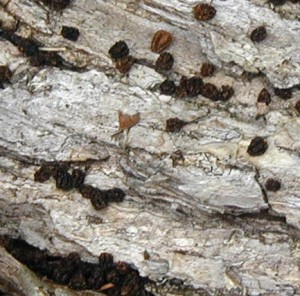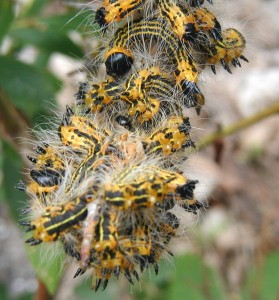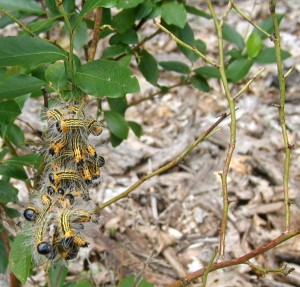Checking the fruit trees out back one day at the beginning of August, I saw two groups of yellow-orange and black-striped caterpillars. There were a dozen or more caterpillars all huddled at the ends of two empty branches of a blueberry bush. They must have eaten the blueberry leaves with abandon as all the leaves were gone on the stems that the squishy critters were found. None of the other four blueberry plants had any of these caterpillars.
Funny thing is I found them by spotting their poop. Those little grenades tend to collect under caterpillar feeding areas and give away the hungry camoflaged mouths.

Once you see the scat you can more easily spot the critters who deposited it. Caterpillars that have found the right food source will stay put and continue to feed, so their scat is usually directly below where they’ve been feeding. It’s a little surprising that I didn’t see the critters first, because they were all huddled together at the end of the branches.

Large grouping of caterpillars huddled on one stem near other stems that they stripped of leaves.

The blueberry shrubs and other fruit trees were checked often in the following weeks, but we haven’t seen this type of caterpillar again. I wonder what type of butterfly they would have morphed into. It’s really too bad they chose to eat from that blueberry bush!

I believe that caterpillar is Radcliffe’s Dagger Moth (Acronicta radclifei).
Thanks for the ID, Pat! What sources do you like for looking up caterpillars?
The Radcliffe’s Dagger Moth, if you look at pictures, has a very distinctive red marking on the head.
I found a bunch of these this morning on my blueberry bushes. I think they are Yellow-Necked Caterpillar. Some of the pictures you’ll find won’t match because the coloration has two variations. From Peterson First Guides: Caterpillars.
Thanks, Jeanne!
I do think you’re right. The colors may not be exact, but the behavior is spot on, see: Yellow-Necked Caterpillar. These guys were definitely huddled near the end of branches and when disturbed they lifted both ends up so their bodies were in a U-shape. I didn’t see any this year on our blueberries.
Thanks for chiming in! Good luck with your blueberries. Did you hand-pick the caterpillars off your bushes?
I just found yellow caterpillars with lengthwise tan stripes on my blueberries. They are similar in shape to the ones pictured above. These also group and form a u-shape when disturbed. There is no red on them. I have the entire batch plus the affected striped branches in a clear garbage bag. Would the be a version of the Radcliffe,s Dagger Moth?
Thanks,
Anna
Hi Anna,
The red on these wiggly critters seems to be diagnostic for the Radcliffe’s Dagger Moth, so without a photo we can’t tell what species of caterpillar you’re looking at. You might try the discoverlife catalog to search for a photo.
Good luck!
How and what do you use to treat. We have 3 bushes and two are almost gone. HELP!
J.M. —
As much as possible we don’t treat our food plants and rely on manual methods of removal. Hand-pick those caterpillars off of there or take snips to a few branches to remove bigger numbers all at once.
When there are lots of pests we do take to the sprayer bottle and give them a squirt of a soapy hot pepper and garlic spray. Easy to wash off and non-toxic, too. Seems to work pretty well.
Hopefully, it’s late enough in the year that losing leaves now won’t affect next year’s crop. Let us know how it works out for ya!
Yes I think most of them are right because I just recently found some on my blue berry trees , it’s the end of August and they did that same thing ( they made a U-shape when disturbed , I noticed that they had been in a herd almost , feeding off of the blueberry leaves , one down about keeping them is that they scat everywhere !!!????
One way to find those voracious caterpillars is to look for their scat. Sometimes they blend so well with the vegetation that the scat left behind is more obvious to see.
How do I permanently get rid of these little caterpillars? Is there a spray that I can buy. They have infested a pin oak and a mimosa. Please advise. Thank you
Hey Mark,
If the caterpillars are the same Yellow Neck Caterpillars who bunch together at the ends of branches, you’re in luck because that makes them easy to remove from the plants they’re infesting. Not all caterpillars do this “herding” behavior, but it does make it easier to get a whole bunch at one time, however you remove them.
Sorry, but there just isn’t a spray that can permanently remove them. Remember, the adults are moths who lay eggs that hatch into caterpillars that molt several times and then cocoon before being transformed into the flying adult. With a life cycle like that we’re out of luck on totally getting rid of any caterpillar. We can’t catch all of those pesky moths (or butterflies) so we’re stuck with being observant gardeners.
Remove the ones you can reach and stay vigilant! Good luck!
I just found a few clusters of these Yellow Necked Caterpillars on one variety of Blueberry in my patch. Since it looked like they could have stinging hairs, I mixed up a bottle of organic Neem insecticide to use. If that doesn’t work, I’ll use another organic, Safer brand of Bacillus Thuringensis (sic). That’s a safe bacteria that quickly infects and kills all types of caterpillars, it’s also been used for years with great results.
Hi Ken,
I always find it interesting when insects are found on the same type of plants in a variety of areas. It makes sense though. If a restaurant has a salad bar that’s where you’ll find me, not at the meat carving station!
BT is a safe bacteria and if I were going to spray an insecticide it might be the first I’d try.
Thanks for your tips and GOOD LUCK!
Oh dear!! Mowed my grass Friday and by Sunday one of my blueberry bushes was stripped of every leaf. Upon close inspection,I discovered the culprits….fat striped caterpillars! !! I plucked them off by hand from my remaining bushes. I just hope the mutilated one will bounce back next year.
Yikes, Bgl!
Caterpillars are truly voracious! We’ve seen them destroy entire oak trees up here in Pennsylvania – from the gypsy moth of course.
I do think the blueberry bushes will come back next year. Take care to watch them in late summer then for these unwanted critters and they should survive ok. Good luck!
Just found a whole bunch of them on two of our blueberry bushes. They are totally denuding them. This is the first year we have had them, and we’ve had the blueberry bushes for three years. They seem to have appeared from no where. Thankfully it is the end of the season, but we hope this doesn’t hurt the bushes’ ability to bear fruit next year.
Hey Dino,
Since comments about the yellow and black caterpillars are rolling in here at the end of August, I keep checking our blueberry bushes daily for the hungry visitors. Yes! They seem to appear rather quickly and eat even faster! Did you manually remove them from the bushes? Just curious….
Blueberry bushes are not the only thing these pests eat.
Check your azaleas and rhodos, they make fast work of these too.
Thanks for the tip, CW!
This time of year when everything is so dry, it pays to take a second look at anything that’s still green. All kinds of pests will be looking for a drink anywhere they can find one!
On my Rhus in AZ. First time and evergreen shrub is 10 yes old. Common name every green sumac. I pick them off one step on them. Yucky, messy.
Yes, Jovi. Very messy.
When I found the lot of them scrambled to the tip of a branch, I just whacked off the end of that stick and then it wasn’t so messy. Still, I’ve squashed too many caterpillars to be proud of it. I agree, yuck.
JD: Discovered the striped worms on our blueberry plants (late Sept) and hand picked.
First time seen in our Great Falls, Va garden.
Yesterday I found the same kind of caterpillars on one of my blueberry bushes. First they were hard to see and blend in with the remaining branches after the leaves are eaten off. I took a bucket with enough water in it and dropped them in. They drowned alright. I touched them with a rubber glove since they are nasty looking. I must have gotten all of them. Checked one more time today.
Hey JD!
I do think hand picking is the easiest way to get rid of them. Thanks for chiming in!
Hi Laura!
I keep checking mine but there haven’t been many caterpillars this late summer on the blueberry bushes. Maybe it has to do with how hot and dry it’s been? Hopefully, we won’t have to worry come Spring. Good on ya’!
Found the caterpillars on the end of one blueberry bush limb in Virginia. First time since we planted the bushes 3 years ago. Dropped in soapy water.
Thanks for your comment. You’ve reminded me it’s the time of year to be vigilant in checking the blueberry bushes for these voracious caterpillars. They always seem to show up in early August here in PA.
Love your simple solution of soapy water!
I just found them (exactly as described in the chain above) on a blueberry bush I planted earlier this season in Fire Island, N.Y. The other bushes seem fine.
Hey Loren,
Did you pluck them off the bush or give them the soapy treatment?
Thanks for all the descriptions. Found these caterpillars on my blueberry bushes here in Athens GA. They devoured five bushes before I discovered them. Hand picked them off. Found nests of smaller ones with dozens grouped together. Will check nightly now that I found them.
Hi Beverly,
So, these little buggers are around Athens, Georgia, too! So far, people have commented here that they’re found in NY, PA, VA, GA and AZ.
The yellow-necked caterpillar can infest all sorts of tree leaves and are especially damaging to ornamentals and other fruit trees. Be ware!
We have these now. Just collected them in a jar. I believe they are a Datana. Pretty sure it is Drexelii but can’t confirm that. Squish em.
Hey Pat!
How many times did you say “Ewwww!” when you squished them? Simple and effective!
They are here in NC also, hubby used ” Goo-gone ” for paint and it killed them right off, they are totally stripping our beloved blueberry bushes, first year with this issue, will keep a watch out and hope they recoup next year
Hi Laura,
Yeah, I guess that paint stripper would make pretty quick work of them! I wonder, since it’s so late in the growing season, whether it’s really an issue with the blueberry bushes growing well the following year if only a couple or few branches were stripped. It won’t be long til all the leaves are on the ground anyhow. Might be different outcome if all the leaves were eaten by the caterpillars.
Thanks for letting us know they’re in NC, too.
hot sauce, had raccoons tearin up my blue berries also, peppermint oil mixed hot sauce fixed that problem, hot sauce for the catapilars
Hole lee cow! I was just out looking at my blueberries and man o man! Those caterpillars were all over one bush and had completely striped another! Gleaned what I could for remedies and put some dish soap, apple cider vinegar, some juice from halapenas I canned but nobody could eat, and some baking soda. Put that in the spray bottle and it knocked em dead faster than you can say kiss my blueberry! Keeping my spray bottle handy in case more show up or these turn into zombies! Thanks to this site for all the help!
Thanks for your input, Kevin! Too bad for the caterpillars, but I’ve been wondering who’s been beating my to my blueberries and I’ll bet coons are the culprit! I have the bushes netted and haven’t caught the robins or chipmunks in there but each morning you can see the netting has been disturbed! Bummer….
That’s great, Charles! You’ll just have to remember to wash your blueberries before eating them. I don’t think I’d like a spicy hot, vinegary, soapy blueberry, but if it saves them for your mouth then great! They’re little piggies, aren’t they?
My blueberry bushes are about 30 years old and I have never seen these yellow necked caterpillars until today.I snipped off the branch they were huddled on and you know the rest.I only had two bunches on one bush.The next thing I did was hit the internet and found this site.Thanks to everyone for sharing.I learned a lot.I guess we can add West Virginia to the list of places these little pests like to visit.I will be checking my bushes often.
Glad to be of help, Carolyn. My bushes were hit this week too!
We’ve had our blueberry bushes for many years and this is the first year I’ve ever seen these critters. Not sure what they were & I didn’t want to touch them with bare hands so we used gloves. Went online to find out what they were and see from all these comments we’re not the only ones that have them. We have Japanese beetles hitting them too but not like these caterpillars.
I agree, Judy. Japanese beetles can do some damage on the leaves but that’s little compared to the whole stripping of branches by these caterpillars. You’re a smart cookie for using gloves!
Just found them on our blueberry bushes in Kentucky as well, found them pretty quick so hopefully no damage done.
That’s great, Curt! It seems most of us find them after they’ve consumed a great deal of a blueberry bush and we finally see the bare branches. Hope you got to eat your berries!
After decades of growing blueberries in New Hampshire, I have just found these voracious caterpillars. I have manually removed what I found and sprayed BT on the bottoms of the stems. Hopefully if any of these critters crawl up the stems the BT will do it’s job. I will stay diligent and manually remove what I find. Thank you for this site.
Great Donald! Do let us know if the BT works!
I’m also in NH and just found these on one of our blueberry bushes. Never have seen them before.
Thanks for letting us know they’re in New Hampshire. Alive and well in PA!